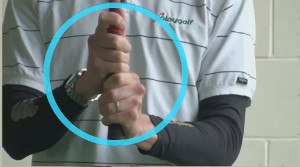
In golf, the term “baseball grip” or “10-finger grip” refers to a specific hand placement on the golf club. It is an alternative grip style that differs from the more common interlocking or overlapping grips.
The baseball grip gets its name because it resembles the grip used in baseball or softball, where all ten fingers are in contact with the club. In this grip, both hands are placed on the club without interlocking the fingers or overlapping the little finger of the top hand with the index finger of the bottom hand.
The key features of the baseball grip are as follows:
- Both hands are placed side by side on the club, with all ten fingers making contact with the grip.
- The palms of both hands are facing each other, creating a “neutral” grip position.
The baseball grip is often used by beginners, junior golfers, or players with smaller hands who may find it more comfortable or easier to control the club. It can provide a sense of stability and security, as all fingers are engaged in the grip.
However, it's worth noting that the baseball grip may limit the ability to rotate the hands naturally during the swing and can potentially affect the release of the clubface. Many professional golfers and experienced players tend to prefer the interlocking or overlapping grip for better control and clubface manipulation.
The choice of grip style is subjective and can vary depending on individual preference, hand size, and comfort. Golfers are encouraged to experiment with different grip styles and seek guidance from a professional instructor to find the grip that works best for their game.
A grip style used by a small percentage of golfers, the baseball grip emulates the way a baseball player holds the bat. Rather than joining the hands by locking or overlapping fingers, the golfer’s are touching but not linked. The left thumb may extend down the club’s handle, as with the Vardon or Interlocking grip methods.




